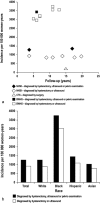Uterine Fibroids: Burden and Unmet Medical Need
- PMID: 29100234
- PMCID: PMC6193285
- DOI: 10.1055/s-0037-1607264
Uterine Fibroids: Burden and Unmet Medical Need
Abstract
Uterine fibroids affect a wide cross-section of the population, with prevalence, symptom severity, and overall disease burden generally higher among black women, likely due to both genetic and environmental factors. Potential symptoms of uterine fibroids include painful and excessive uterine bleeding, interference with everyday life and self-image, and impaired fertility. Because of the high estimated prevalence and costs associated with treatments, the direct and indirect costs of uterine fibroids are substantial for both the health care system and the individual patient. Special patient populations—such as black women, women seeking to retain fertility, and women with asymptomatic fibroids—have particular treatment needs that require a variety of diagnostic methods and treatment options. Despite the widespread occurrence of uterine fibroids and newer treatment options, little high-quality data are available to formulate evidence-based guidelines that address these unmet patient needs. Specific areas in need of attention include improving diagnostic techniques, increasing patient access to early treatment, and identifying best practices for this diverse patient population.
Conflict of interest statement
Disclosure The authors report no conflicts of interest in this work.
Figures

Similar articles
-
Uterine Fibroids: Bridging Genomic Defects and Chronic Inflammation.Semin Reprod Med. 2017 Nov;35(6):494-498. doi: 10.1055/s-0037-1607240. Epub 2017 Nov 3. Semin Reprod Med. 2017. PMID: 29100237 Review. No abstract available.
-
Patient-Centered Care and Uterine Fibroids.Semin Reprod Med. 2017 Nov;35(6):560-564. doi: 10.1055/s-0037-1607267. Epub 2017 Nov 3. Semin Reprod Med. 2017. PMID: 29100243 Review. No abstract available.
-
Uterine Leiomyoma: New Perspectives on an Old Disease.Semin Reprod Med. 2017 Nov;35(6):471-472. doi: 10.1055/s-0037-1606569. Epub 2017 Nov 3. Semin Reprod Med. 2017. PMID: 29100233 No abstract available.
-
The Effect of Uterine Fibroids on Infertility: A Systematic Review.Semin Reprod Med. 2017 Nov;35(6):523-532. doi: 10.1055/s-0037-1607295. Epub 2017 Nov 3. Semin Reprod Med. 2017. PMID: 29100240 No abstract available.
-
Current and Emerging Medical Treatments for Uterine Fibroids.Semin Reprod Med. 2017 Nov;35(6):510-522. doi: 10.1055/s-0037-1606302. Epub 2017 Nov 3. Semin Reprod Med. 2017. PMID: 29100239 Review. No abstract available.
Cited by
-
Assessment of a Digital Symptom Checker Tool's Accuracy in Suggesting Reproductive Health Conditions: Clinical Vignettes Study.JMIR Mhealth Uhealth. 2023 Dec 5;11:e46718. doi: 10.2196/46718. JMIR Mhealth Uhealth. 2023. PMID: 38051574 Free PMC article.
-
What We Know about the Long-Term Risks of Hysterectomy for Benign Indication-A Systematic Review.J Clin Med. 2021 Nov 16;10(22):5335. doi: 10.3390/jcm10225335. J Clin Med. 2021. PMID: 34830617 Free PMC article. Review.
-
The Usefulness of Immunohistochemistry in the Differential Diagnosis of Lesions Originating from the Myometrium.Int J Mol Sci. 2019 Mar 6;20(5):1136. doi: 10.3390/ijms20051136. Int J Mol Sci. 2019. PMID: 30845657 Free PMC article. Review.
-
Endocrine disrupting chemicals and reproductive disorders in women, men, and animal models.Adv Pharmacol. 2021;92:151-190. doi: 10.1016/bs.apha.2021.03.008. Epub 2021 May 3. Adv Pharmacol. 2021. PMID: 34452686 Free PMC article.
-
Epigenomic tensor predicts disease subtypes and reveals constrained tumor evolution.Cell Rep. 2021 Mar 30;34(13):108927. doi: 10.1016/j.celrep.2021.108927. Cell Rep. 2021. PMID: 33789109 Free PMC article.
References
-
- Drayer S M, Catherino W H. Prevalence, morbidity, and current medical management of uterine leiomyomas. Int J Gynaecol Obstet. 2015;131(02):117–122. - PubMed
-
- Stewart E A, Cookson C L, Gandolfo R A, Schulze-Rath R. Epidemiology of uterine fibroids: a systematic review. BJOG. 2017;124(10):1501–1512. - PubMed
-
- Breastcancer.org. Breast Cancer Statistics. Available at:http://www.breastcancer.org/symptoms/understand_bc/statistics. Accessed September 26, 2017
-
- NCI. SEER Cancer Stat Facts: Ovarian Cancer. National Cancer Institute Web Site.http://seer.cancer.gov/statfacts/html/ovary.html. Accessed September 26, 2017
Publication types
MeSH terms
LinkOut - more resources
Full Text Sources
Other Literature Sources
Medical

